
November 18, 2023
Pilot Safety Blog – Ballooned, Bounced and Porpoise Landings
Attempting to “stick” a mishandled landing has the potential to lead to significant aircraft damage and the possibility of injury to occupants if a landing known as ballooned, bounced and porpoise landing occurs. Ballooned, bounced and porpoise landings may be triggered by environmental factors; however, excessive approach speed and control inputs by pilots are the determinant factors in the severity of the outcome.
Should a ballooned, bounced and porpoise landing start to develop the pilot must take prompt and decisive action to avoid adverse outcomes. Understanding the dynamics and cause will equip pilots with knowledge on how to avoid, recognise and recover from these types of landing mishaps.
A note on the correct landing technique
Correct landing technique involves the aircraft approaching the runway at just the right speed to permit sufficient lift to be generated to transition from the descending approach flightpath to one that is parallel to the runway (round-out) and to set the landing attitude (flare or hold-off) just above the runway without stalling.
During the hold-off at the correct airspeed, the opportunity for the aircraft to climb or lift off again is limited and the aircraft is likely to settle onto the runway. At higher airspeeds, the aircraft is at risk of climbing away from the runway or lifting off again. At the correct round-out height there is insufficient height to attain a high vertical speed at touch-down that may cause the aircraft to land heavily.
The correct landing technique for an aeroplane with a tricycle undercarriage involves the main wheels contacting the runway first. The Centre of Gravity (CoG) is positioned forward of the main wheels and provides a nose-down moment when the aircraft’s weight starts being supported by the main wheels. The nose-down moment produced by weight and undercarriage acts to decrease the Angle of Attack (AoA) of the wing and improves the likelihood for the aircraft to settle on the runway. This is one of the advantages of the tri-cycle undercarriage.
Ballooned landing
A ballooned landing is an aerodynamically induced vertical departure (climb) away from the runway usually caused by a pilot attempting to land with excess airspeed. At higher airspeeds, a longer period of time is required to “wash off” the airspeed (float) which increases the risk for the aircraft to climb away or lift off again from the runway.
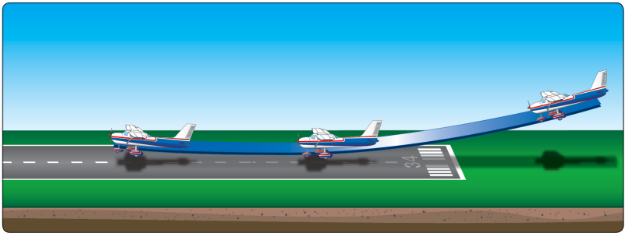
Mis-timed and excessive nose-up elevator control inputs during the round-out or hold-off at an excessive airspeed will likely cause the aircraft to climb. A sudden increase in head-wind component (a gust) could be the initial cause for a ballooned landing; however, excess airspeed is required, and incorrect pilot control inputs will increase the severity.
During the ballooning climb airspeed is lost, lift decreases, and the aircraft may enter a state where there is insufficient airspeed to effectively maintain control of the aircraft’s descent back to the runway resulting in a hard landing. Attempting to control the balloon with the elevator may lead to the pilot “overcontrolling” and causing the aircraft to nose into the runway or into a series of swoops and dives called Pilot Induced Oscillation (PIO).
Managing a ballooned landing requires perfectly timed and precise control inputs. The safest option is to go around because an incorrectly managed balloon could lead to a hard, bounced or porpoise landing.
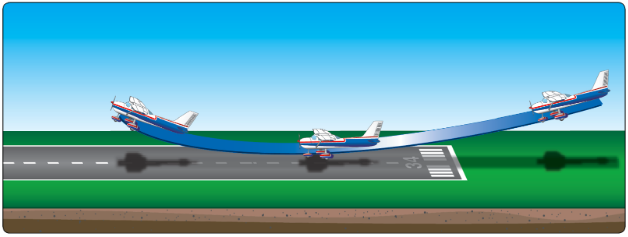
Bounced landing
A bounced landing is a kinetically induced vertical departure from the runway where the aircraft is briefly pushed back up by the action of undercarriage shock absorbers and tyres as they recoil from the runway. Bounces are caused by descending onto the runway at a high vertical speed usually after having rounded out too high or rounding out too late.
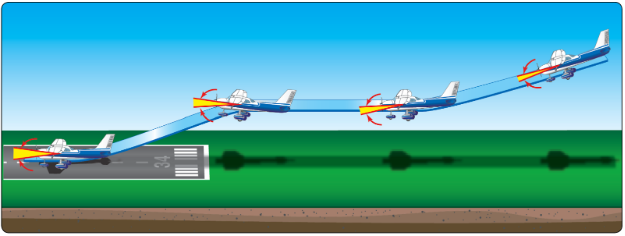
The term bounced landing usually refers to a landing limited to one significant oscillation before settling on the runway. The bounce may be brief, just the time it takes for the aircraft to fall back onto the runway, or they may be sustained in a coupled aerodynamic balloon. A landing involving the nosewheel bouncing off the runway will likely lead to the aircraft pitching up, and with sufficient airspeed, a balloon is likely to follow.
Aerodynamically lifting off after contact with the runway is often referred to as a bounced landing though, more correctly, it is a ballooned landing after touching down. Managing a bounced landing requires perfectly timed and precise control inputs. The safest option is to go around because an incorrectly managed bounce could lead to a hard or porpoise landing.
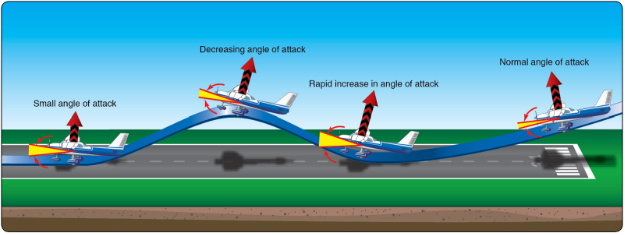
Porpoise landing
A porpoise landing is an aerodynamic and kinetic series of vertical departures from the runway where the aeroplane bounces and balloons in a series of nose-down impacts and pitch-up rebounds. To an onlooker, the landing resembles a porpoise breaching the surface of the water, diving back in nose first and re-emerging again in a series of graceful and apparently playful leaps. It’s neither graceful nor much fun in an aeroplane. Porpoise landings often follow a ballooned or bounced landing.
Development of the porpoise landing:
1. The pilot attempts to land the aeroplane at excess airspeed.
2. The nosewheel contacts the runway before the mainwheels after a bounce, balloon or failure to round out properly. At flying speed, the wings will be supporting the weight of the aircraft and the nosewheel is more likely to elastically recoil from the ground (kinetic bounce).
3. With the aircraft still flying and free to rotate in the pitching plane, the recoil of the nosewheel leads to a pitch-up attitude change.
4. At an airspeed above the minimum for level flight, the increase in AoA created by the pitch-up attitude change generates additional lift on the wings and the aircraft starts climbing away from the runway (aerodynamic balloon).
5. If the throttle is closed for landing, airspeed will decay rapidly, the lift will decrease, and the aircraft’s trajectory will transition to a descent.
6. As the aircraft starts descending, the natural stability of the aircraft pitches the nose down. This results in a further decrease in lift and leads to the aircraft descending nosewheel first back onto the runway with increased vertical velocity and a harsher bounce.
7. The cycle is then repeated, likely with greater amplitude.
Ground effect contributes by creating a pitch-down moment and allows the aircraft’s wings to develop greater lift for the same pitch attitude and airspeed. The change in longitudinal pitch balance may lead to the nose-wheel touching down before the mainwheels and the increased lift potential may cause the pilot to “over-control” the aircraft trying to find the correct landing attitude.
The amplitude of the first few oscillations usually increases as the pitch up induced by subsequent rebounds increases with higher nosewheel impact forces with each bounce. If the throttle is closed, the amplitude of the oscillations will eventually decay as airspeed decreases (energy dissipates). Power or thrust will add energy to the equation and may increase the amplitude and duration of the oscillations.
An attempt to control (suppress) a porpoise landing may exacerbate the problem if a Pilot Induced Oscillation (PIO) occurs. In a PIO/porpoise landing the pilot’s corrective control inputs, likely exceeding those required and lagging where they would be effective, become roughly in phase with the aircraft’s natural oscillations and increase in amplitude and duration of the oscillations.
Attempting to manage a porpoise landing is likely not possible. Pilot reaction times, aircraft inertia and delays in the aircraft’s response to control inputs make it almost impossible for a pilot to anticipate and make corrective control inputs. The safest option is to go around with a porpoise landing likely to result in damage to the aircraft.
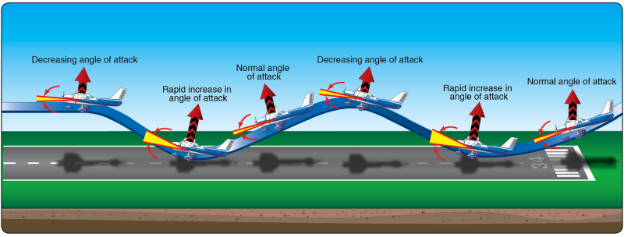
Consequences of ballooned, bounced and porpoise landings
Harsh contact on the nosewheel in a pitch-down attitude may cause substantial damage to the aircraft. The nosewheel briefly bears the weight and downward momentum of the aircraft. This causes the nose oleo and tyre to compress and combined with the aircraft’s nose-down attitude may result in the propeller contacting the runway, leading to severe damage to the propeller and engine.
Very harsh contact on the nosewheel transmits forces through the structure that connects the nose undercarriage to the airframe. Ultimately, the nosewheel undercarriage could collapse.
Additionally, the undercarriage is commonly directly connected to the engine firewall or indirectly through the aircraft’s engine mount. Strong forces and moments generated may damage the engine mounts and firewall. The engine firewall may also support the aircraft’s cockpit control mechanisms. A damaged firewall may compromise or even render the flight controls inoperative.
Delays in going around after a ballooned, bounced or porpoise landing may lead to control difficulties or stalling. After ballooning or bouncing airspeed rapidly decreases. Applying full power after the airspeed has decreased may generate strong yaw and pitch-up moments that may lead to an undesired aircraft state. The aircraft may not have sufficient thrust to effectively overcome drag at low airspeed, the aircraft’s track may diverge from the runway, initial climb performance may be poor and if not properly handled by the pilot, the aircraft may stall.
Proper pilot actions
– Fly the right approach. Do not attempt to land with excessive airspeed. Strictly apply stabilised approach criteria and perform a missed approach and go-around for deviations from flightpath and/or airspeed.
– If the aircraft (all but slightly) balloons during the hold-off, perform a missed approach and go-around. The risk of a landing mishap (bounced–porpoise landing) to follow is too great to risk.
– Round out at the correct height. Perform a missed approach and go-around after rounding out too high or too low. The risk of a hard landing will likely follow.
– If the aircraft does bounce on landing, perform a missed landing and go around from the first bounce. The likelihood of aircraft damage increases with each bounce.
– Should a porpoise landing start to develop, perform a missed landing and go around as soon as possible to avoid further control difficulties and undesired aircraft states.
CASA pilot competencies: control ballooning during flare and control bouncing after touchdown are described in the CASR Part 61 Manual of Standards, Elements A4.1 (b) (i) & (iii) and A4.4. As part of your flight training your instructor will give you training on how to avoid and manage slightly ballooned and bounced landings, and of course missed approaches and go-arounds.
The safest response to ballooned, bounced and porpoise landings, no matter how slight, is to perform a missed approach and go-around.
👉🏻 The Airplane Flying Manual – FREE downloadable FAA publication 👈🏻
What Else Should I Know?
We’ve compiled a few useful posts that might help you out. Wherever you are on your aviation journey, the team at Learn To Fly Melbourne are here to help. We want you to pass your exams and have an excellent career, so please reach out if we can help support you through your course and studies!
Becoming a Flight Instructor
Working as a Flight Instructor is one of the most rewarding aviation careers you can choose. The feeling of watching someone you trained fly solo for the first time is like nothing else, trust us. To work as a Flight Instructor, you need to obtain a Flight Instructor Rating (FIR). It’s a rewarding and exciting challenge and a fantastic option for anyone chasing a career in aviation. Let’s take a look at what’s required to become a Flight Instructor, what pathways there are and why you should consider enrolling today.
How To Finance Your Commercial Pilot Licence (CPL)?
Are you dreaming of soaring through the skies as a commercial pilot in Australia? Obtaining a Commercial Pilot Licence (CPL) is a thrilling journey and enables you to chase a career in aviation. Undertaking a CPL course can be expensive, but there are plenty of options to help you achieve your dream. In this comprehensive guide, we’ll delve into the requirements, costs, and benefits of Learn To Fly’s Commercial Pilot Licence course.









